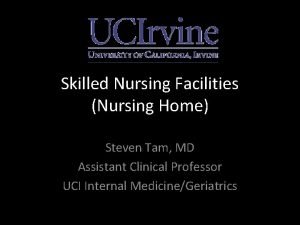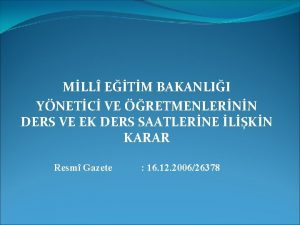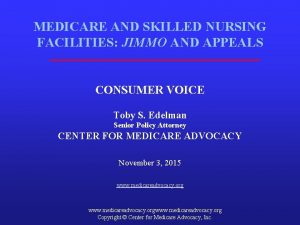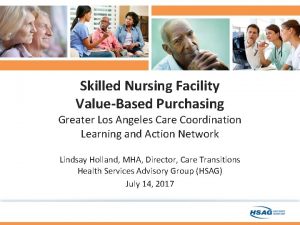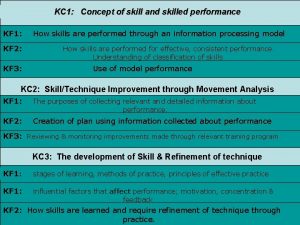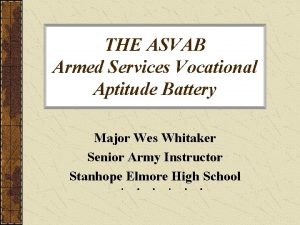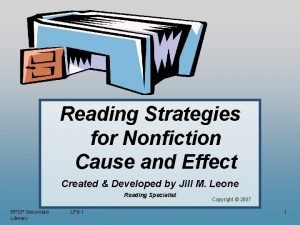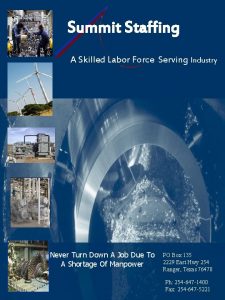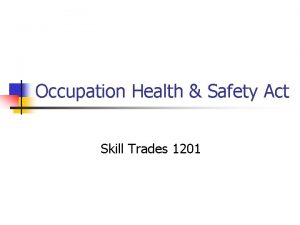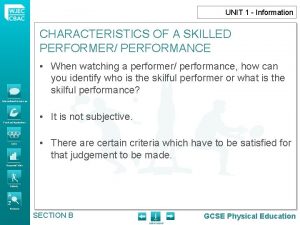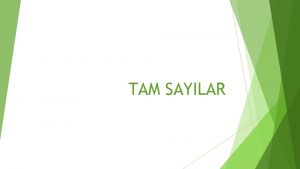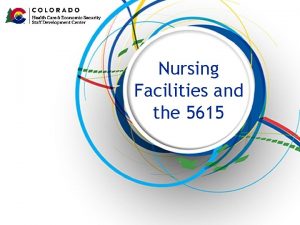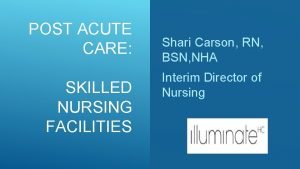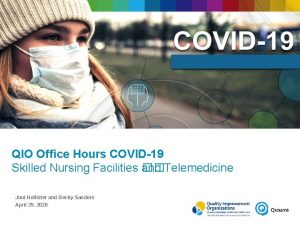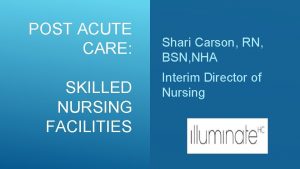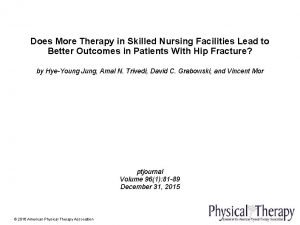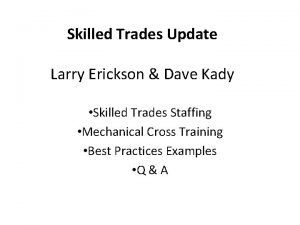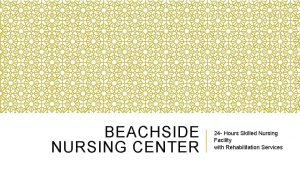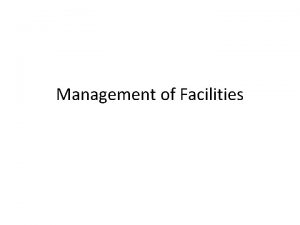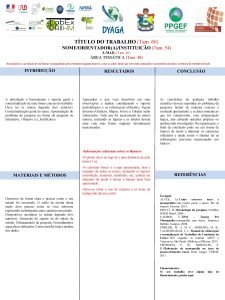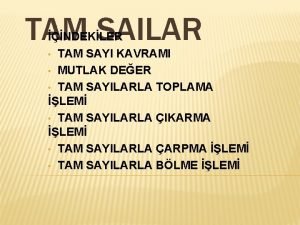Skilled Nursing Facilities Nursing Home Steven Tam MD


























- Slides: 26

Skilled Nursing Facilities (Nursing Home) Steven Tam, MD Assistant Clinical Professor UCI Internal Medicine/Geriatrics

Educational Objectives: • Become familiar with Nursing Homes and other facilities • Understand who are candidates for Nursing Homes and other facilities • Define the services provided. • Identify important issues at Nursing Homes

The Stats! • Approximately 1. 5 million Americans (~4. 2%)>65 have spent time in a skilled nursing facility – 2004 National Nursing Home Survey » Jones AL, et al. 2009 Vital Health Stat 167: 1 -155. • Expected to be 3 million in 2030 if continues at this rate. • ~50% of those 95 and older live in nursing homes. • 51% of nursing home residents require assistance with all ADLs

Skilled Nursing Facilities (Nursing Homes) • Skilled Nursing Facility: part of a Nursing Home or Hospital that provides skilled nursing care. • Registered Nurses who provide skilled nursing care to people, along with interdisciplinary staff/team – – Licensed practical and vocational nurses Physical Therapy, Occupation Therapy Speech Therapy Social Worker/Case Manager • Skilled care usually a short period – Custodial Care may be required for longer period

Skilled Nursing Facilities (Nursing Homes) • A licensed physician supervises each patient’s care and a nurse or other medical professional is almost always on the premises. • >80% of nursing homes use community physicians to provide care • Average family physician supervises 9. 6 nursing home residents and conducts 2. 3 nursing home visits per week » 2008 AAFP survey

Skilled Medical Care • Skilled Services: • RN doing wound care or administering and monitoring IV antibiotics • A physical therapist working to improve strength and balance in a patient with difficulty walking • A speech therapist helping a patient speak and swallow after a stroke. • An occupational therapist helping a patient relearn dressing, grooming and eating. • Skilled care may also involve managing injections, ostomy management and tracheotomy care amongst other needs.

Custodial Care • Need assistance with ADLS – Bathing – Dressing – Eating – Grooming – Getting in and out of bed, or walking around – Toileting (incontinence care) • Often provided at a Nursing Home • May also be temporary

Who May Need a Nursing Home? • Skilled Nursing facility is for Patients who: – Require a short stay for skilled services prior to returning to previous residence – Can no longer care for their own personal needs, such as feeding, bathing, toileting (custodial care) because of medical, physical, behavioral problems – Need more care than can be provided at home – Has extensive medical needs requiring daily attention, or monitoring

Who May Need a Nursing Home? • Special Needs in Skilled Nursing Facility – – Dialysis, Dementia care, Respiratory Care, Parkinson’s Care – Hospice care, Chronic Psychiatric Care

Nursing Home Costs • Medicare coverage for skilled care: – Medicare Part A (Hospital Insurance) – Qualifying 3 day hospital stay 30 days prior to Nursing home admission – 100 day benefit period (renewable if not hospitalized, or in SNF for 60 consecutive days) – 1 st 20 days, Medicare covers full cost • Between Day 21 and 100 there is a copay • After Day 100, Medicare covers nothing.

Nursing Home Costs • Medigap may cover deductibles/other charges • Medicaid for Custodial care, Long Term Care Insurance

Nursing Home Costs • 2004: Met. Life Market Survey of Nursing Home and Home Care costs, $192/day, or $70, 080 a year – Private room • Shared room $169/day, or $61, 685 a year. • Costs can vary with location – – Alaska, highest rates for private room $204, 765/yr, or $561/day – Shreveport, Louisiana, lowest $36, 135/yr, or $99/day

What’s the Alternative? • • • Assisted Living facility Subsidized senior housing Board and care homes Continuing care retirement communities Program of All-Inclusive Care for the Elderly and the Social Managed Care Plan

What’s the alternative? ALF • In 2002, ~1 million people lived in assisted living. » Mc. Cormick JC, et al. 2003 Health Care Finance Rev 24: 143 -150 • Transition period? • Offers help with ADLS, but none or limited medical care. • >80% require help with ADLS • 40% describe their health as poor

What’s the Alternative? ALF • Greater emphasis on personal privacy and autonomy. • No onsite RN • ALF provide only personal assistance that can be performed by someone with little or no medical training. – Patient’s may visit MD if onsite clinic available, at MD office, or if there is a Housecall MD.

What’s the Alternative? Continuing Care Retirement Communities • Continuing Care Retirement Communities: provides independent living, housing-withservices, and Nursing home care in one location • Enables seniors to remain in a familiar setting as they grow older • Many enter while they are healthy and active, knowing they will be able to stay in the same community • May be able to move within the different levels of care.

Important Issues in Skilled Nursing Facilities • Transitions of Care – To and From Acute Care settings – To Home and or other Long Term Care options • End of Life Care – ~1/3 rd of nursing home residents die within one year of admission – Estimated by 2020, 40% of all deaths will occur in nursing homes. » Oliver DP, et al. 2004 J Am Med Dir Assoc 5(3): 147 -155 – End of life care similar to that in the community setting, and hospice and palliative care can be provided in the skilled nursing facility

Important Issues in Skilled Nursing Facilities • Infections – Similar nosocomial infection rates to acute care hospitals? – MRSA 10 -30% prevalent in nursing homes. » Pacio GA, et al. 2003 Infect Control Hosp Epid 24(4): 246250 – C. Difficile Colitis – Scabies – Influenza, Tuberculosis – Infection control programs

Important Issues in Skilled Nursing Facilities • Abuse and Neglect – Surveys of nursing home residents suggest abuse, neglect common? • Frailty – Fatigue – Inactivity – Slowness – Weakness – Weight loss

Important Issues in Skilled Nursing Facilities • Nutrition and weight loss – Various strategies • • Liberating diet Frequent meals Supplements between meals Resistance strength training Family presence and socialization Assess feeding disability and need for assistance Appetite stimulants? – Artificial Nutrition (maybe a limited role).

Important Issues in Skilled Nursing Facilities • Pain Management – Est. 45 -80% of nursing home residents with chronic pain » Unwin BK, et al. 2010 American Family Physician 81(10): 1229 -1237 • Pressure Ulcers: can be common in Nursing homes – management principles usually similar to the community.

Important Issues in Skilled Nursing Facilities • Urine Incontinence and Retention – ~55% of nursing home residents » Unwin BK, et al. 2010 American Family Physician 81(10): 12291237 • Treatment strategies (evaluation, review meds, toileting programs, pharmacologic therapy) • Catheters: must require a valid reason!

Important Issues in Skilled Nursing Facilities • Falls – 20% of deaths from falls are amongst nursing home residents. » www. cdc. gov/ncipc/factsheets/nursing. htm – Causes maybe multifactorial • Restraints – Careful and thorough review, used only when no safer alternative. • Adverse Drug Events – Common in nursing homes; 40 -50% considered preventable. » Gurwitz JH, et al. 2000 Am J Med 109(2): 87 -94

Important Issues in Skilled Nursing Facilities • Dementia – ~67 -78% of nursing home residents – Behaviors can be a serious problem • Nonpharmacologic treatment (identify triggers, activities, environment modification, staff and family education). • Pharmacologic treatment: higher risk of morbidity/mortality?

Important Issues in Skilled Nursing Facilities • Delirium: up to 60% of nursing home residents • Depression: estimated that 12 -16 percent of older adults in nursing homes have major depression » Unwin BK, et al. 2010 American Family Physician 81(10): 12291237

Conclusions • A Nursing Home is a facility where an interdisciplinary team provides care for the patient – Including nursing services, physical and occupational therapy • There alternatives to the Nursing Home. • Those requiring a Nursing Home may do so for a variety of reasons
 Steven tam md
Steven tam md Bt rehber öğretmen çalışma saatleri
Bt rehber öğretmen çalışma saatleri Prastari instrumenti
Prastari instrumenti How to win a medicare appeal for skilled nursing
How to win a medicare appeal for skilled nursing Skilled nursing facility value based purchasing program
Skilled nursing facility value based purchasing program Skilled performance
Skilled performance Operationally attuned
Operationally attuned Define skilled human resources
Define skilled human resources Armed services vocational aptitude battery definition
Armed services vocational aptitude battery definition Cause and effect non fiction
Cause and effect non fiction Skilled staffing jean
Skilled staffing jean 5 characteristics of skilled performance
5 characteristics of skilled performance Critical thinking in society
Critical thinking in society Semi skilled labor
Semi skilled labor Skilled trades 1201
Skilled trades 1201 Characteristics of skilled performers
Characteristics of skilled performers Go to my house
Go to my house Unit 3 home sweet home
Unit 3 home sweet home André fougeron
André fougeron Apa arti dari home care
Apa arti dari home care Softly and tenderly jesus is calling
Softly and tenderly jesus is calling She said that, home economics stands for the ideal home.
She said that, home economics stands for the ideal home. Perbedaan home care dan home visit
Perbedaan home care dan home visit Oak springs mobile home park
Oak springs mobile home park Home sweet home survive prayer
Home sweet home survive prayer Homes for sale in roebuck sc
Homes for sale in roebuck sc Principles of home visit
Principles of home visit
